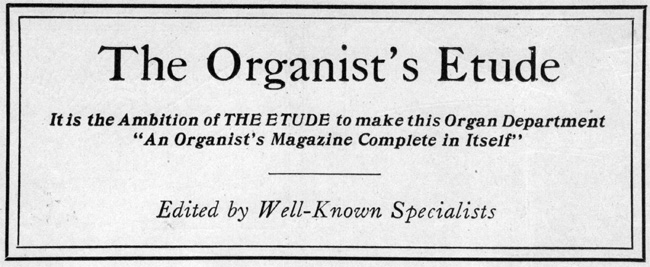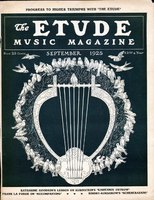
By W. Stanfield Cooper, Jr.
Sooner or later every organist is called upon to play an instrument with which he is not familiar. Even if he does not desire to do substitute work, the weddings of his friends make this call upon him, to say nothing of the audition that precedes the obtaining of a new position. The opportunity of familiarizing one’s self with the instrument in such cases is scant, if not altogether impossible; and the man who can give the most creditable performance is the one whose musical ability is not hampered by his being unable to recognize quickly the possibilities, limitations, and peculiarities of a strange organ.
Each organ builder seems to foster distinct ideas and hobbies which he incorporates in his work. For example, there is one whose stop tablets are lifted, or the upper end pushed, to draw the stop—just the opposite of common practice. The writer had the opportunity of speaking with this builder and of asking him why he maintained this peculiarity. He replied that he was not the peculiar one, for did not the swell pedal move backward for a crescendo, and did not the crescendo pedal move the same way? Then why not the stop keys? The reason seems logical enough, but it does not help the organist who finds the desired pianissimo passage a blare of trumpets, or his decrescendo a popping-in of louder stops. While not so annoying or distracting as mechanical differences, varying ideas of pipe voicing can also cause discomfort. One finds that the Salicional can be anything between the Aeoline and the realm of the Gamba.
No Substitute for Practice
Of course there is no substitute for an opportunity to practice, and the visiting organist is indeed fortunate to be able to study a strange instrument before performing on it. But there is another element which greatly influences a man’s adaptability and readiness to control the unfriendly organ—one that makes any possible practice more telling and at the same time is invaluable where circumstances prevent previous preparation. This is a knowledge of the mechanics and construction of the three different types of organs. Each of them is likely to present its own limitations and difficulties; and each has its own diseases and bad habits. With this knowledge there are fewer surprises, and difficulties can be anticipated and avoided. This might seem to be advice that is self-evident; but the writer recently was called upon to substitute, and, upon inquiring from the regular organist, was informed that the action was tracker. The instrument proved to be tubular-pneumatic. That organist has been doing very creditable work for his church for a number of years; but it is probable that his ignorance of the mechanics of the organ would make him slow and awkward on a strange bench.
The three types of action now in use are the tracker, the tubular-pneumatic, and the electric. The organist should first identify the type and he then will almost know what facilities he may expect upon studying the console. Usually it is not hard to distinguish between them, even with a very casual examination. In the tracker action the console is invariably a part of the organ case. The touch is inclined to be stiff, especially when manuals are coupled, and the stop knobs are likely to require a firm pull. Perhaps the greatest tell-tale, however, is the visible action of the keys when manuals are coupled, so that the keys of the swell lower as those of the great are played. This type of action is now found only in organs of very moderate size, and the organist can expect few interesting stops and a severe limitation in the couplers, there being usually only those of the manuals to pedal and unison between manuals. Most of the older instruments will be found to be this type; and often they are not in good condition. Their action has been repaired and adjusted for many years until the pressure required to depress each key is noticeably different from that of the next one; and often the valves are not opened fully so that the pipes are under-blown and speak slowly. On the whole, however, the tracker-action organ is not tricky, and its markings are simple and lucid. The point to keep in mind is to handle things firmly. Press keys to their full depth; pull stops their full length.
Tubular-Pneumatic Action
Briefly, the tubular-pneumatic action depends upon the sudden drop of air pressure in a tube, causing the collapse of a tiny bellows or ”pneumatic” which in turn actuates the valve. Since both keys and stops have to move nothing except a small air control, the action is very light, and stop-tablets may be used instead of draw-knobs. Some of these organs retain knobs for speaking stops and use the tablets for the couplers. In such cases, of course the knobs move only a fraction of an inch and require only the touch of a finger. When a stop or coupler is drawn, or when keys are depressed, there is a characteristic “pflup” that bears witness to this type of action. The console, if not directly at the organ case, is seldom more than a few feet from it. Sometimes the builder has extended this distance, and in such cases the organist must be prepared for a drag in the action. Although the note will sound only a fraction of a second after the key is depressed the result can be very annoying, especially in rapid repetition of chords as found in many accompaniments.
The tubular-pneumatic action is the most tricky of all and can cause much discomfort and embarrassment. This is especially true in damp weather or when there has been a pronounced change in the temperature, particularly if the organ is near a door or window or against an outside wall. Perhaps the trick most noticeable to the audience, and therefore most embarrassing to the organist, is the sounding of pipes when they should not. It is good to know the whys and wherefores of such conditions; but here space permits only a few suggestions that will aid in avoiding the occurrence.
Starting the Blower
Before starting the blower, be sure that all stops are closed, not neglecting the crescendo pedal or combination-pistons. This precaution will prevent agonizing groans as the pressure rises in the chests. Some notes might continue to sound persistently, especially if the organ has not been used for a few days, but in many cases just the striking of the key several times will prove sufficient to stop it. Move all the stops and couplers quickly and be very careful about making any changes during a part of the service where a possible sound from the organ might be most distracting and annoying. Before turning off the blower the stops again should all be closed. This not only reduces the probability of noise as the pressure goes down but also helps in avoiding it when the organ is again brought into use. With this type of action, combination-pistons and pedals become possible. Generally it is a good rule to avoid using them unless it is known what to expect. Frequently a tubular instrument, well-mannered otherwise, will display temperament when these pistons are used.
However, despite these possible occurrences, the tubular-pneumatic organ will be found very light playing, pleasing, and interesting.
We now come to the electric action. Although not so much heralded electricity has worked the wonders in the organ that it has in other lines. There seems to be no limit to the possibilities both in tonal effects and convenience for the player.
The console can be placed any distance from the pipes; in fact it is often movable within a wide area. Little lights show when the pressure is up and also what combination-piston is in effect. The organist will recognize the electric instrument readily and he has reason to do so enthusiastically.
It is very dependable and seldon (sic) misbehaves. Since the keys and stop control have only to make contact between two copper tabs, the action can be as light as desired. Some builders have even gone so far as to make the required pressure adjustable.
The Couplers
The only probable difficulty that the visiting organist will meet will be the difference in the facilities and equipment of different instruments. There is usually an array of couplers, combination-pistons and pedals, their position and action depending on the opinion of the builder. Often there is a tab by itself or among the couplers, innocent looking, and no more conspicuous than the others, marked “Sw. Unison” or “Gt. Unison.” This should be drawn immediately; for, unless this is on, the organist will find that no stop will sound in its normal pitch. More than one good organist has approached an instrument and, after carefully selecting his stops, has been at a loss when there was no response to his playing.
Occasionally a note will not sound, due to the oxidation of the small contacts. However the striking of the key several times will be sufficient to clean this and bring the note into action. The same word of warning can be given on the combination pistons here as was on those of the tubular organ. While they are not tricky or liable to cause any noise, it is hard to know just what is coming. In some instruments the pistons actuate the stop keys; in others, each stop has a corresponding light which shows whether the stop is drawn or not. Of course in either of these cases the organist will be greatly helped in the use of the pistons. Other organs are arranged so that the organist can adjust the combinations drawn by the pistons at the bench, but this requires some knowledge of the instrument and may well be left alone the first time it is played upon.
So much for what may be expected generally from the different types of action. Let us now consider some positive suggestions. First the visitor should read all stop knobs and couplers carefully, making note of their location and thinking of the sound or function of each as it is read. Particular attention should be given to the couplers, as they always play a very prominent part in obtaining a smooth, dignified performance. If the same stop appears on more than one manual it can safely be assumed that there is but one set of pipes playable from each. Sometimes this would affect the result obtained and should be taken into consideration. Locate the swell pedal and move it several times in order to get the “feel” of it, at the same time distinguish its location carefully from that of the crescendo pedal.
It is best to start out with a combination as near as possible to one with which you are thoroughly familiar. For example, on a two-manual organ, a “P” combination on the swell coupled with an “M. F.” combination on the great, and with a soft pedal coupled to the swell will be found very useful, yet safe. The great is ready for solo work, and considerable expression is possible just with the use of the swell pedal and alternating the manuals. As familiarity is gained, excursions into the other facilities of the instruments can be taken gradually but always with caution.
Perhaps these precautions and suggestions instill the idea that it is best for the organist to stay at home. But banish the thought! There are really few things that can compare, in interest or satisfaction, with meeting and playing on a different instrument, particularly if some practice is possible before a public performance.



